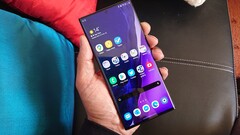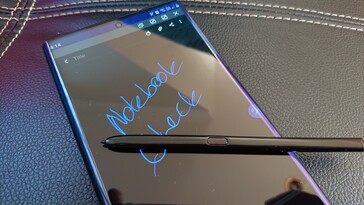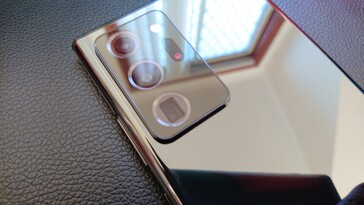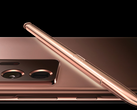Intro:
Let’s just cut straight to the chase - Samsung has stiffed international customers by reusing the already controversial Exynos 990 from the Galaxy S20 series in its latest flagship. The Exynos 990 was already demonstrably inferior to the Snapdragon 865 SoC in the Galaxy S20 series and now Samsung is rubbing salt into the wounds of its international customers by using the upgraded Snapdragon 865+ SoC in the US, Chinese, and Korean variants of the Galaxy Note 20/Ultra models. This puts the Exynos 990 variants at a completely unacceptable performance disadvantage and undoubtedly sours the experience of owning one - particularly at the price Samsung is charging. For this amount of money, you want to know you’ve got the best of everything and you are arguably getting the third-best chipset available for the handset behind the Snapdragon 865+ and the Snapdragon 865.
Design and build quality:
From a design and build perspective, the Ultra is everything that you would expect from Samsung. It is a refinement of last year’s Galaxy Note 10 design with even thinner top and bottom bezels situated in an aluminum frame and wrapped in the new Gorilla Glass Victus front and back - the first smartphone to feature the new glass technology. It sets itself apart from Gorilla Glass 5 and 6 by combining their respective scratch resistance and drop resistance into one all-conquering glass. Our model is the Mystic Black variant as it is the only color option for the 12 GB/512 GB configuration in Australia. It has a stunning reflective finish that looks totally high-end.
Audio-Visual Experience:
In terms of its display, the Galaxy Note 20 Ultra features the most advanced panel that Samsung has yet to put in a smartphone. It is a whopping 6.9 inches in size with a Quad HD+ (3088x1440) Dynamic AMOLED 2X Infinity-O panel with HDR10+ certification and Samsung’s all-new Adaptive Frequency technology. This means it can adjust its refresh rate from anywhere as low as 10 Hz when viewing a photo, for example, through to 60 Hz for watching a video and up to 120 Hz when playing a supported game. The aim is to help conserve battery life and optimize the viewing experience at the same time. In practice, it is sumptuous to behold and is easily the best display we have yet to lay our eyes on.
Its audio experience is delivered through a front-firing speaker at the top of the display (which also doubles as the earpiece for calls) which is joined by its stereo companion that fires out of the bottom of the device. The tone and power of these speakers is a clear step up from previous Note models and was a pleasant surprise. Combined with the Ultra’s support for Dolby Atmos, viewing movies through this combined audio-visual experience is a top-shelf pastime. The only downside we noted is that with Atmos enabled, the audio spread with the down-firing speaker creates a slightly imbalanced sound as the sound stage is wider on the right-hand side when in landscape mode.
Cameras:
Another key area for a flagship smartphone like this is its camera optics. The large rear camera housing on the Galaxy Note 20 Ultra 5G incorporates three cameras. These include a 12 MP ultra-wide camera at the top, a 108 MP wide-angle camera in the middle, and a 12 MP telephoto camera at the bottom. Accompanying these is a laser autofocus sensor, with Samsung ditching the 3D ToF sensor it used on the rear of the S20 Ultra that had some issues with focus. While some of the Chinese makers are really pushing the envelope with camera technology and trickery, Samsung has focused on ensuring the optimal user experience for traditional smartphone photography. There is no astrophotography mode or light trail capture mode, but these types of shots can still be achieved in the Pro mode with manual settings. Regardless, it be great see Samsung bring these modes to its devices.
Unlike the 100x Space Zoom found on the Galaxy S20 Ultra, Samsung has also dialed this back to 50x zoom on the Note 20 Ultra. These tweaks show that Samsung listened to the criticism leveled at the S20 Ultra and the changes seen in the Note 20 Ultra are designed to ensure that the quality of its images is paramount. The Galaxy S20 Ultra sits at eighth position on DxOMark’s charts and we anticipate that the Galaxy Note 20 Ultra will certainly beat it. However, we suspect that while it might make it into the top 5, it will probably still lag slightly behind the likes of the Xiaomi Mi 10 Ultra and the Huawei P40 Pro. You can see some sample photos in a range of different lighting situations below - on the whole, they are impressive.
S-Pen
The S-Pen is the signature feature of the Galaxy Note line. With each iteration, Samsung has sought to add new features to the S-Pen, to its credit. Some of the new Air gesture features could be viewed as gimmicks, but there is nothing gimmicky about the lag being reduced to 9 ms. This brings it into the same ballpark as Apple’s Pencil line. Apple calls this level of lag “imperceptible” and the S-Pen now delivers the same level of responsiveness. Having this functionality in a smartphone is great, and it is worth taking the time to learn the various features the S-Pen offers to get full value for your money.
Battery Life and Charging:
While the Galaxy Note 20 Ultra picks up a 4,500-mAh battery, it is only adequate in practice. It will get you through a day of consistent use but even with a display set to draw at Full HD+ and not its native resolution, it still chews up your battery. Good thing the display features a variable refresh rate but it doesn’t completely offset the massive size of its 6.9-inch panel, which is still responsible for draining your charge. There are four different power-mode settings that you can choose from to extend your battery life as well as an adaptive power-saving setting that is by default turned off. It is definitely worth trying these out to maximize your mileage. Less forgivable is Samsung’s strange decision to step back down to 25 W fast-charging from the 45 W fast-charging found on last year’s Note 10 line. With the Chinese competition pushing out devices with 120 W fast charging, it is really odd to see Samsung failing to stay properly competitive in this regard.
Performance:
We’ve already covered Samsung’s appalling decision to use the in-house Exynos 990 in international variants of the Galaxy Note 20 Ultra 5G when it is shipping the same device in the US, China, and Korea with the far superior Snapdragon 865+. On the plus side, the Exynos 990, while clearly an underperformer, is certainly up to the task of keeping things hustling along well enough. There is no noticeable system lag and we haven’t noticed any issues with the chip overheating, and it is entirely capable of delivering on all the new photography and video features that Samsung advertises. Where you will see shortfalls against the Snapdragon 865+ variants are in sustained performance tasks like video-editing and rendering and certainly in intense gaming sessions. In most instances it won’t matter that you have an Exynos 990 variant, but it is a bitter pill to have to swallow nonetheless.
Conclusion:
Despite feeling short-changed by the use of the Exynos 990 in the Galaxy Note 20 Ultra 5G international variant, in everyday use, there is still a lot to like. Its design, form factor and overall usability are very much what you would expect for a device in this class. It is very much in a class of its own when it comes to its S-Pen - even though there are other devices that support stylus input, none can compete head-to-head with the functionality and integration of the way it comes together on the Galaxy Note 20 Ultra 5G. Its audio-visual experience is second-to-none and its cameras are excellent. It ticks almost all the right boxes, but one has to ask, is that really enough for an ultra-premium device?
Keep an eye out for usual highly-detailed and in-depth review coming soon.
Source(s)
Own
























